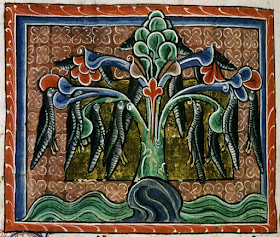A bit of weird (and horribly wrong), medieval trivia.
The barnacle goose was believed to reproduce not by laying eggs like other birds, but by growing in barnacles, and was hence considered acceptable food for Lent. and other fast days.
from - Vincent of Beauvais's great encyclopedia -The vast tome of the Speculum Naturale (Mirror of Nature), divided into thirty-two books and 3,718 chapters, is a summary of all of the science and natural history known to Western Europe towards the middle of the 13th century (his other works were: De eruditione filiorum nobilium ("The education of noble children") and De morali principis institutione ("The moral instruction of a prince")
 |
| The barnacle goose Bodleian Library, MS. Bodley 764, Folio 58v |
...Bishops and religious men (viri religiosi) in some parts of Ireland do not scruple to dine off these birds at the time of fasting, because they are not flesh nor born of flesh... But in so doing they are led into sin. For if anyone were to eat of the leg of our first parent (Adam) although he was not born of flesh, that person could not be adjudged innocent of eating meat
At the Fourth Council of the Lateran (1215), Pope Innocent III explicitly prohibited the eating of these geese during Lent, arguing that despite their unusual reproduction, they lived and fed like ducks and so were of the same nature as other birds.
The question of the nature of barnacle geese also came up as a matter of Jewish dietary law in the Halakha, and Rabbeinu Tam (1100–71) determined that they were kosher (even if born of trees) and should be slaughtered following the normal prescriptions for birds
Today we have a different view of these strange "birds"
What looks like a carpenter's thumb, feels like a rubber hose and is sweeter and more tender than spiny lobster?
Why, gooseneck barnacles.
For some time now, whispers have circulated around the Pacific Northwest about these tasty crustaceans, which in medieval times were named goose barnacles by naturalists who believed geese hatched from them.
By the hundreds of thousands such barnacles, now more often called gooseneck barnacles, decorate sea-splashed rocks on the Northwest spanish Coasts. They were long a delicacy to the Indians of the region who used to scrape them off rocks at great risk and reserve them for tribal elders.
Gooseneck barnacles are a very old tradition in Spain, where they are called percebes. Spaniards pay dearly for them at tapas bars where, displayed on lettuce or ice and served with garlicky aioli.
''We always eat them at Christmas time,'' said Adolfo Calles, a native of Madrid who is now chef and owner of La Gaviota in Seattle. He said he is delighted with the local supply of gooseneck barnacles.
''We boil them in sea water for about four minutes with some onion slices, a lemon and a few bay leaves and serve them cold,'' he said. ''They're great. And they're so cheap here. I know as soon as people find out how good they are they won't be so cheap anymore.''
The Portuguese, who call them percebas, have eaten them for centuries, too, as have the Italians and the French.
A strange tale, with a goose of truth in it.


No comments:
Post a Comment